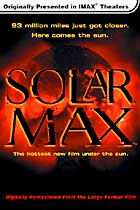
SOLAR MAX
The Globe and Mail, Friday, March 9, 2001
Dark caves, bright sun: big enough for Imax?
By Don Irvine
The Imax movie is a hostage to the monolithic Imax screen, and at its
heart, every Imax movie is about the constant struggle to find subjects
big enough to fill it. Some subjects have worked so far: large, ice-covered
continents, the Earth from space, 600 Kuwaiti oil fires, and the Rolling
Stones. Other things haven't: the life stories of magicians Seigfried
and Roy, computer animation, and three-dimensional images of Elvira, Mistress
of the Dark.
Two new additions to this immense-format collection wrestle with varying
degrees of success with the imperatives of the Imax design. Solarmax is
about the sun, a subject that happily proves to be just about the right
size for Imax. Journey Into Amazing Caves has more of an identity crisis:
Climbing Down Cliffs, Flying Through Canyons and into the Odd Amazing
Cave is more like it.
Like most of their Imax brethren, these movies struggle to construct a
narrative thread that will lead you through both the medium's small time
constraints and massive screen demands. Both films have a surfeit of pin-you-to-your-seat
images, yet only Solarmax manages to convince you that it's a real movie.
You would think that it's not all that tough to make a 40-minute documentary
-- television does it all the time.
Yet Journey Into Amazing Caves serves as a perfect example of how difficult
it has become to make a 40-minute Imax documentary. Structurally, it's
more of an action movie -- something big has to happen every few minutes,
and what normally would be a non-fiction movie's subject matter merely
links the film's spectacular images together however it can.
The nominal subjects are two cave explorers, Hazel Barton and Nancy Aulenbach,
who here serve as the pivot around which images flow. Yet the film doesn't
really give them to us. Its commitment to them as human subjects is strictly
opportunistic -- you learn more about both from the press kit than from
the movie. You sense a hole where the film's emotional heart pretends
to be, and thus are far more aware of the artifice designed to bowl you
over -- the big visuals, the portentous narration and, most disconcertingly,
the music by the Moody Blues. (Why them -- was Enya busy?)
Caves ultimately plays like an indifferently designed carnival ride: There
are nice moments when you're there, but nothing lingers, and you're soon
off to the next one. Solarmax is a different matter. Solarmax too wanders
about a lot to connect its dots, yet it is always drawn back to the inescapable
sun -- as if kept in line by the gravity of its massive subject--and we
are drawn back with it.
The chore of building a 40-minute movie around about 10 minutes of spectacular
new satellite footage of the sun has been neatly finessed by making Solarmax
a guided tour of the sun's history in human civilization.
Part travelogue, part Nova lecture, the movie moves easily between spectacular
footage of Machu Picchu, the Peruvian mountain city where the Incas once
claimed that they anchored the sun to the Earth, and the dazzling graphic
representation of just why the Earth's magnetosphere is so important to
the survival of life. What emerges is a gently moving fusing of the ancient
and the modern; a meeting between the sun-god humans created on Earth,
and the still mysterious and awe-inspiring creature of the modern scientific
heavens.
Solarmax is good enough that you appreciate it for its documentary virtues,
some completely unexpected.
In its own small -- and huge -- way, Solarmax tries to take account of
the finer elements in human religion and science, even managing to fuse
the two in what must be Imax's best closing visual metaphor. If Journey
into Amazing Caves is a thrill ride you move on from and soon forget,
Solarmax is one of the good ones you want to get right back into the lineup
for and go through again.
review source: www.solarmovie.com